A Homebush Plane Crash, 1949
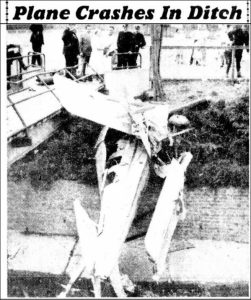
Truth 23 October 1949 p.3
https://trove.nla.gov.au/newspaper/article/168961695
On 23 October 1949, a 21-year-old pilot ran into trouble over Homebush when the engine of his Tiger Moth cut out. On a training flight from Bankstown Aerodrome with the Truscott Flying Club, William Fraser searched desperately for a place to land. From 1,500 feet he spotted the recreation grounds of the Arnott’s biscuit factory near Parramatta Road and made that his goal. On his second attempt he just cleared the high-tension wires but the wind caught the Moth, hurling it into a tall sewage vent, snapping one wing. The plane hit a small iron footbridge over Powells Creek before plunging into the stormwater canal below. Somehow Fraser climbed out of the debris with only a small cut to his upper lip.
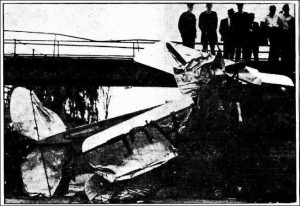
The Sun (Sydney) 22 October 1949 p.1
https://trove.nla.gov.au/newspaper/article/229229621
As the newspapers reported:
‘Had the plane been 15ft higher when it hit the steel pipe it would have crashed into the side of the factory.’[1]
The incident was just one of several accidents suffered by pilots from the Truscott Flying Club during 1949 alone. In April another Tiger Moth had crashed into Sydney Harbour. The pilot and his passenger were rescued by three boys in a boat.[2] Truscott Flying Club, named after WWII flying Ace, ‘Bluey’ Truscott, who was killed during WWII, [3] was short-lived and had been sold by December 1950.[4]
Coincidentally, the aerial photographer, Milton Kent[5], photographed Homebush in the same year. Using the details reported in the newspaper articles, it is possible to locate the position of Fraser’s crash. Have a closer look at the photos below.
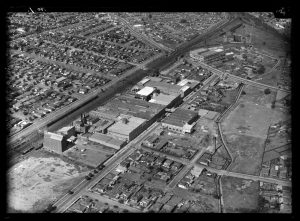
Milton Kent’s 1949 aerial photograph of Homebush and the Arnott’s factory. The recreation grounds can be seen on the right. Courtesy State Library of NSW.
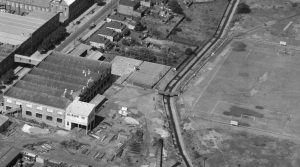
A cropped version of the above Milton Kent image from 1949 shows the bridge and sewer vent in the centre, next to the recreation grounds and tennis court – and very close to the Arnott’s building.
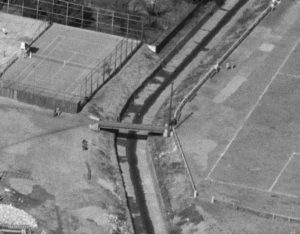
Another closer shot shows the sewer vent and bridge quite clearly, as well as a few employees of Arnott’s walking on the recreation grounds.
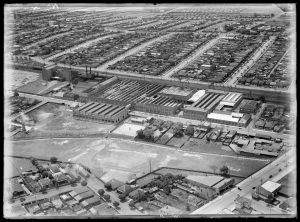
Another Milton Kent photo over Homebush in 1949. The canal and recreation grounds can be seen near the bottom of the photo. Courtesy State Library of NSW.
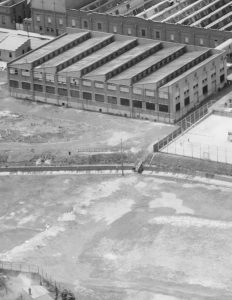
It is clear from this cropped photo just how close the Tiger Moth came to crashing into one of the Arnott’s buildings.
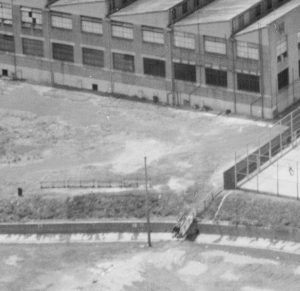
Cropped again from the Milton Kent image showing a dry canal with the sewer vent and bridge.
Today a small, disused bridge stands in almost exactly the same position over Powells Creek as the bridge damaged by Fraser’s Tiger Moth in 1949. New playground equipment has been installed nearby in Ismay Reserve, which now occupies the site of the former Arnott’s recreation grounds, in the shadow of the M4.
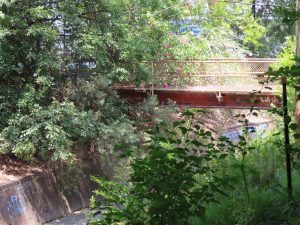
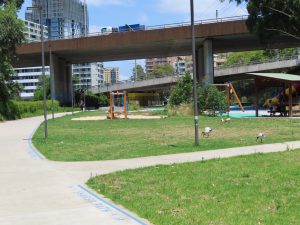
Disused bridge over Powells Creek, in almost exactly the same location as the Ismay Reserve, the site of the former Arnott’s recreation grounds.
bridge hit by Fraser’s Tiger Moth. Courtesy Strathfield Local Studies Courtesy Strathfield Local Studies 12 January 2023
12 January 2023
By J.J. MacRitchie
Local Studies Advisor
References
[1] Sunday Times (Perth) 23 October 1949 p.2 https://trove.nla.gov.au/newspaper/article/59496905[2] The Newcastle Sun 19 April 1949 p.1 https://trove.nla.gov.au/newspaper/article/158243776
[3] Stephens, Alan. Biography – Keith William (Bluey) Truscott – Australian Dictionary of Biography https://adb.anu.edu.au/biography/truscott-keith-william-bluey-11886
[4] Sydney Morning Herald 14 December 1950 p.9 https://trove.nla.gov.au/newspaper/article/27568938
[5] Milton Kent – Wikipedia https://en.wikipedia.org/wiki/Milton_Kent
